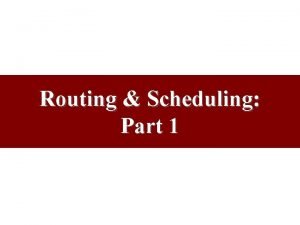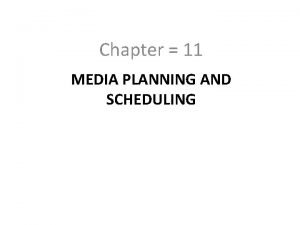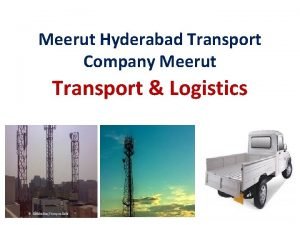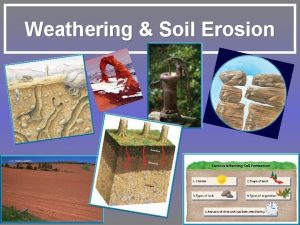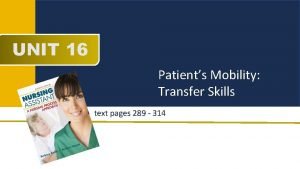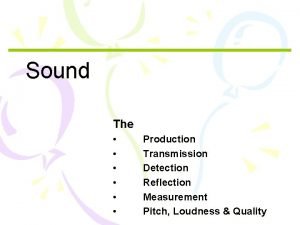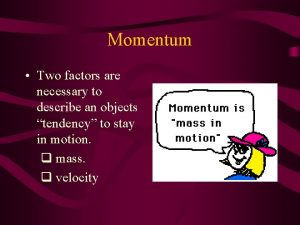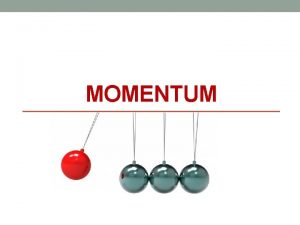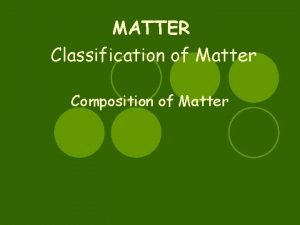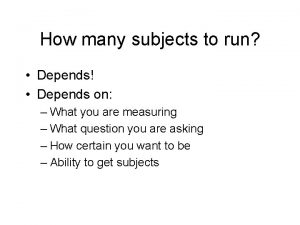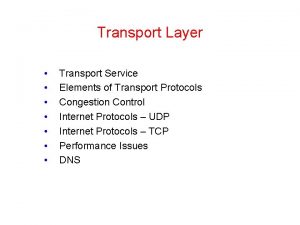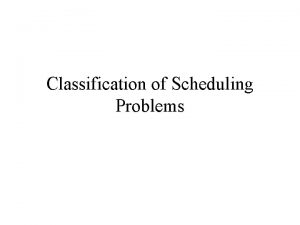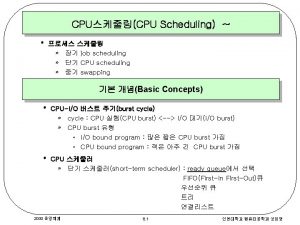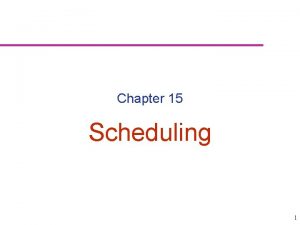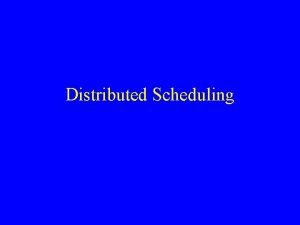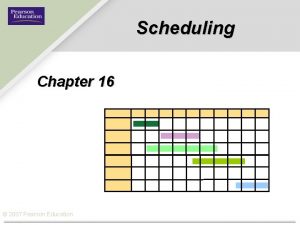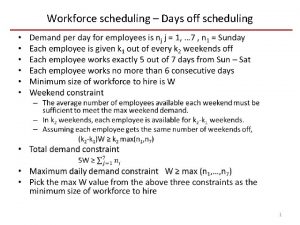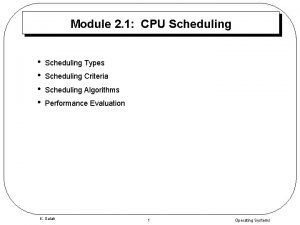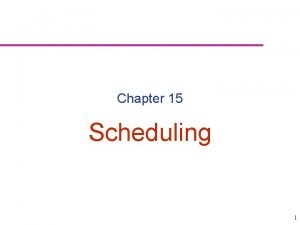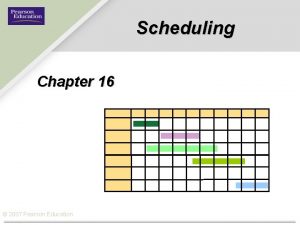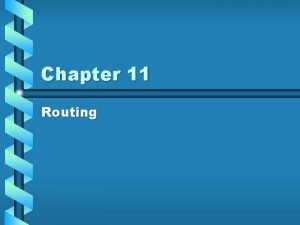Routing Scheduling Part 1 Transport Service Selection Depends






































- Slides: 38

Routing & Scheduling: Part 1

Transport Service Selection • • • Depends on variety of service characteristics Not all service characteristics are of equal importance Most common bases used for modal choice: – – – • Cost of service Average transit time (speed) Transit-time variability (dependability) Other bases used – – – – Capability Availability & adequacy of equipment Availability of service Frequency of service Security Claims handling Shipment tracing Problem-solving assistance

Basic Cost Trade-Offs • • When alternative modes are available, the one chosen should be the one that offers the lowest total cost consistent with customer service goals. Often, cost trade-offs must be used. Speed & dependability affect both the seller’s & buyer’s inventory level, as well as the inventory that is in transit. Slower, less reliable modes require more inventory in the distribution channel

Example • • A Birmingham luggage company maintains a finishedgoods inventory at its plant Currently, rail is used to ship between Birmingham and the firm’s West Coast warehouse Average transit time is T = 21 days 100, 000 units are kept at each stocking point with the luggage having an average value of C = $30 per unit Inventory carrying costs are I = 30 percent per year There are D = 700, 000 units sold per year out of the West Coast warehouse Average inventory levels can be reduced by 1 percent for each day of transit time that is eliminated.

Example Transport Services Available to the Firm Rate ($/unit) Door-to-Door Transit Time (days) No. of Shipments per year Rail 0. 10 21 10 Piggyback 0. 15 14 20 Truck 0. 20 5 20 Air 1. 40 2 40 Transport Service

Example • Different modes affect the time inventory is in transit • Annual demand (D) will be in transit by the fraction of the year represented by T/365 days, where T is the average transit time • Annual cost of carrying this in-transit inventory is ICDT/365 • Average inventory at both ends of the channel can be approximated as Q/2, where Q is the shipment size • Holding cost per unit is I x C – Note that C must reflect where the inventory is in the channel – Value of C at the plant is the price ($30 per unit) – Value of C at the WC warehouse is C + transportation rate • Total annual transportation cost is R x D

Example Method of Computation Rail Rx. D (. 1)(700, 000) = 70, 000 ICDT/365 [(. 3)(30)(700, 000)(21)]/365 = 363, 465 Plant Inventory ICQ/2 [(. 3)(30)(100, 000)] = 900, 000 Warehouse Inventory IC”Q/2 [(. 3)(30. 1)(100, 000)] = 903, 000 Cost Type Transportation In-transit Inventory Total for Rail $2, 235, 465

Example Cost Type Transportation In-transit Inventory Plant Inventory Warehouse Inventory Method of Computation Piggyback Rx. D (. 15)(700, 000) = 105, 000 ICDT/365 [(. 3)(30)(700, 000)(14)]/365 = 241, 644 ICQ/2 [(. 3)(30)(50, 000)(0. 93)c] = 418. 500 IC”Q/2 [(. 3)(30. 15)(50, 000)(0. 93)c] = 420. 593 Total for Rail C = accounts for improved transport service & number of shipments per year $1, 185, 737

Example Cost Type Transportation In-transit Inventory Plant Inventory Warehouse Inventory Method of Computation Truck Rx. D (. 2)(700, 000) = 140, 000 ICDT/365 [(. 3)(30)(700, 000)(5)]/365 = 86, 301 ICQ/2 [(. 3)(30)(50, 000)(0. 84)c] = 378, 000 IC”Q/2 [(. 3)(30. 2)(50, 000)(0. 84)c] = 380, 520 Total for Rail C = accounts for improved transport service & number of shipments per year $984, 821

Example Cost Type Transportation In-transit Inventory Plant Inventory Warehouse Inventory Method of Computation Air Rx. D (1. 4)(700, 000) = 980, 000 ICDT/365 [(. 3)(30)(700, 000)(2)]/365 = 34, 521 ICQ/2 [(. 3)(30)(25, 000)(0. 80)c] = 378, 000 IC”Q/2 [(. 3)(30. 4)(25, 000)(0. 80)c] = 190, 755 Total for Rail C = accounts for improved transport service & number of shipments per year $1, 387, 526

Example Modal Choice Cost Type Transportation Method of Computation Rail Piggyback Truck Air Rx. D 70, 000 105, 000 140, 000 980, 000 ICDT/365 363, 465 241, 644 86, 301 34, 521 Plant Inventory ICQ/2 900, 000 418, 500 378, 000 182, 250 Warehouse Inventory IC”Q/2 903, 000 420, 593 380, 520 190, 755 Totals $2, 235465 $1, 185, 737 $984, 821 $1, 387, 526 In-transit Inventory

Factors Other Than Transportation Cost that Affect Modal Choices • Effective buyer/seller cooperation is encouraged if a reasonable knowledge of the other party’s costs is available • If there are competing suppliers, buyer & supplier should act rationally to gain optimum cost-transport service tradeoffs • Offering higher-quality transportation services than the competition may allow the seller to charge a higher price for the product • Elements in the mix change frequently – Transport rate fees, product mix changes, inventory cost changes, & transport service retaliation by competitors • If buyer makes the transport choice, seller’s inventories are impacted as well, which may impact price charged for the product

Vehicle Routing & Scheduling • Selecting the best paths for the transport mode to follow to minimize travel time or distance reduces transportation costs and improves customer service • Start with determining shortest possible routes based on – Transit time – Distance – Cost • Incorporate restrictions

Restrictions on Vehicle Routing & Scheduling • Each stop on the route may have volume to be picked up as well as delivered • Multiple vehicles may be used using different capacity limits to both weight and cube • Maximum total driving time allowed before a rest period must be taken is 8 hours • Stops may permit pickups/deliveries only at certain times of day (time windows) • Pickups may be permitted on a route only after deliveries are made • Drivers may be allowed to take short rests or lunch breaks at certain times of the day.

8 Principles for Good Routing & Scheduling • Load trucks with stop volumes that are in the closest proximity to each other – minimizes interstop travel between them • Stops on different days should be arranged to produce tight clusters – develop overall route, plus daily routes • Build routes beginning with the farthest stop from the depot • Sequence of stops on a truck route should form a teardrop pattern – try to keep route paths from crossing

8 Principles for Good Routing & Scheduling • The most efficient routes are built using the largest vehicles available – allocate largest vehicles first, then smaller • Pickups should be mixed into delivery routes rather than assigned to the end of routes • A stop that is greatly removed from the other stops in a route cluster is a good candidate for an alternative means of delivery • Narrow stop time window restrictions should be avoided – see if you can renegotiate the time window restrictions

Routing & Scheduling: Part 2

The Sweep Method of Routing • Simple method to use • Fairly accurate with a projected error rate of about 10% • Good to use when results must be obtained in short order or • Good to use when a good solution is needed as opposed to an optimum solution

The Sweep Method of Routing • Locate all stops including the depot on a map or grid • Extend a straight line from the depot in any direction • Rotate the line (clockwise or counterclockwise) until it intersects a stop – Will the inserted stop exceed the vehicle’s capacity? – If not, continue rotating the line until the next stop is intersected – Will the cumulative volume exceed the vehicle’s capacity? – Continue process until vehicle’s capacity would be exceeded • Sequence the stops to minimize distance

Sweep Method Example • Gofast Trucking uses vans to pickup merchandise from outlying customers • Merchandise is returned to a depot where it is consolidated into large loads for intercity transport • Firm’s vans can haul 10, 000 units • Completing a route typically takes a full day • Firm wants to know – How many routes (trucks) are needed – Which stops should be on the routes – And sequence of stops for each truck

Sweep Method Example Pickup Stop Data: quantities shown in units E H 1000 4000 A F 2000 3000 D Depot G 2000 3000 I 1000 L K 2000 3000 B C 2000 J 2000

Sweep Method Example “Sweep” method solution E H 1000 4000 A F 2000 3000 D Depot G 2000 3000 I 1000 L K 2000 3000 B C 2000 J 2000

Sweep Method Example “Sweep” method solution E H 1000 4000 F 3000 Route 1 10, 000 units 2000 D Depot G 2000 1000 K 2000 3000 B 3000 I L 2000 A C 2000 J 2000

Sweep Method Example “Sweep” method solution E H 1000 4000 F 3000 2000 D Depot G I 1000 L 2000 A Route 1 10, 000 units 2000 K 2000 Route 3 8, 000 units 3000 B 3000 Route 2 9, 000 units C 2000 J 2000

The Savings Method of Routing • Developed by Clarke & Wright (1963) • Objective is to minimize the total distance traveled by all vehicles and • To minimize (indirectly) the number of vehicles needed to serve all stops • Has been proven to be – Flexible enough to handle wide range of practical constraints (forms routes & sequences of stops on routes simultaneously) – Relatively fast for problems with a moderate number of stops – Capable of generating near optimum solutions

The Savings Method of Routing • Begin with a dummy vehicle serving each stop and returning to the depot. – Gives the maximum distance to be experienced in the routing problem • Two stops are then combined together on the same route – Eliminates one vehicle and travel distance is reduced • To determine which stops to combine on a route, the distance saved is calculated before and after each combination – This calculation is repeated for all stop pairs – The stop pair with the largest savings value is selected to be combined

The Savings Method of Routing Initial routing – Route distance = d 0, A + d. A, 0 + d 0, B + d. B, 0 d 0, A Stop A d. A, 0 Depot (0) d. B, 0 d 0, B Stop B

The Savings Method of Routing Combing 2 stops on 1 route – Route distance = d 0, A + d. A, B + d. B, 0 d 0, A Stop A d. A, B Depot (0) d. B, 0 Savings value of S = d 0, A + d. B, 0 - d. A, B Stop B

The Savings Method of Routing Initial routing – Route distance = d 0, A + d. A, 0 + d 0, B + d. B, 0 d 0, A = 100 Atlanta (A) d. A, 0 = 100 Jacksonville (0) d. B, 0 = 85 Birmingham (B) d 0, B = 85 Initial routing – Route distance = d 0, A(100) + d. A, 0(100) + d 0, B(85) + d. B, 0(85) = 370 miles total

The Savings Method of Routing Combining 2 stops on 1 route – Route distance = d 0, A(100) + d. A, B(145) + d. B, 0(85) = 330 total miles d 0, A = 100 Atlanta (A) d. A, B = 145 Jacksonville (0) d. B, 0 = 85 Birmingham (B) Savings value of S = d 0, A(100) + d. B, 0(85) - d. A, B(145) = 40 miles saved

The Savings Method of Routing • If a third stop (C) is to be inserted between stops A and B, where A and B are on the same route, the savings value is expressed as • S = d 0, C + d. C, 0 + d. A, B - d. A, C - d. C, B • If stop C were inserted after stop B, the savings value is expressed as • S = d. B, 0 - d. B, C + d 0, C • If stop C were inserted before stop A, the savings value is expressed as • S = d. C, 0 - d. C, A + d 0, A

The Savings Method of Routing Initial routing – Route distance = d 0, A + d. A, 0 + d 0, B + d. B, 0 + d 0, C + d. C, 0 d 0, A Stop A d. A, 0 Depot (0) d. B, 0 Stop B d 0, C d. C, 0 Stop C

The Savings Method of Routing Combining 3 stops on 1 route – Route distance (additional stop added after 1 st 2 stops) = d 0, A + d. A, B + d. B, C + d. C, 0 d 0, A Stop A d. A, B Depot (0) Stop B d. B, C d. C, 0 Stop C Savings value of S = d 0, C + d. C, 0 + d. A, B - d. A, C - d. C, B

The Savings Method of Routing Initial routing – Route distance = d 0, A(100) + d. A, 0 (100) + d 0, B(85) + d. B, 0 (85) + d 0, C (25) + d. C, 0 (25) = 420 total miles d 0, A = 100 Atlanta (A) d. A, 0 = 100 Jacksonville (0) d. B, 0 = 85 d 0, B = 85 Birmingham (B) d 0, C = 25 Gadsden (C) d. C, 0 = 25

The Savings Method of Routing Combining 3 stops on 1 route – Route distance (additional stop added after 1 st 2 stops) = d 0, A(100) + d. A, B(145) + d. B, C(65) + d. C, 0(25) = 335 miles d 0, A = 100 Atlanta (A) d. A, B = 145 Depot (0) Birmingham (B) d. C, 0 = 25 d. B, C = 65 Gadsden (C) Savings value of S = d. B, 0 (85) - d. B, C(65) + d 0, C(25) = 45 miles saved Earlier O to A to B to O route (330 miles) plus 0 to C to 0 route (50 miles) = 380 miles

The Savings Method of Routing Combining 3 stops on 1 route – Route distance (additional stop added between 1 st 2 stops) = d 0, A(100) + d. A, C(125) + d. C, B(65) + d. B, 0(85) = 375 miles d 0, A = 100 Atlanta (A) d. A, C = 125 Depot (0) Gadsden (C) d. B, 0 = 85 d. C, B = 65 Birmingham (B) Savings value of S = d 0, C(25) + d. C, 0(25) + d. A, B(145) - d. A, C(125) - d. C, B(65) = 5 miles saved Earlier O to A to B to O route (330 miles) plus 0 to C to 0 route (50 miles) = 380 miles

The Savings Method of Routing Combining 3 stops on 1 route – Route distance (additional stop added before 1 st 2 stops) = d 0, C(25) + d. C, A(125) + d. A, B(145) + d. B, 0(85) = 380 miles d 0, C = 25 Gadsden (C) d. C, A = 125 Depot (0) Atlanta (A) d. B, 0 = 85 d. A, B = 145 Birmingham (B) Savings value of S = d. C, 0(25) - d. C, A(125) + d 0, A(100) = 0 miles saved Earlier O to A to B to O route (330 miles) plus 0 to C to 0 route (50 miles) = 380 miles

The Savings Method of Routing When 3 rd Stop Routes Added After 1 st 2 Between 1 st Before 1 st 2 2 Routes Eliminated Miles Saved B > C; C > 0 B>0 45 A > C; C > B 0 > C; C > 0; A >B 5 C>A 0 > A; C > 0 0
 Level pool routing example
Level pool routing example Mark tinka
Mark tinka Hydrologic routing and hydraulic routing
Hydrologic routing and hydraulic routing Power routing in vlsi
Power routing in vlsi Principles of good routing and scheduling
Principles of good routing and scheduling Sjn scheduling
Sjn scheduling Factors affecting media planning
Factors affecting media planning Secondary active transport
Secondary active transport Primary active transport and secondary active transport
Primary active transport and secondary active transport Now answer the following questions
Now answer the following questions Active vs passive transport venn diagram
Active vs passive transport venn diagram Unlike passive transport, active transport requires
Unlike passive transport, active transport requires Primary active transport vs secondary active transport
Primary active transport vs secondary active transport Bioflix activity membrane transport active transport
Bioflix activity membrane transport active transport Active and passive transport
Active and passive transport Bioflix activity membrane transport active transport
Bioflix activity membrane transport active transport Balancing selection vs stabilizing selection
Balancing selection vs stabilizing selection Artificial selection vs natural selection
Artificial selection vs natural selection K selection r selection
K selection r selection Natural selection vs artificial selection
Natural selection vs artificial selection Difference between continuous and discontinuous variation
Difference between continuous and discontinuous variation Directional selection example
Directional selection example What is exponential growth in ecology
What is exponential growth in ecology Natural selection vs artificial selection
Natural selection vs artificial selection Two way selection and multiway selection
Two way selection and multiway selection Multiway selection in c
Multiway selection in c Mass selection and pure line selection
Mass selection and pure line selection Contractor past performance examples
Contractor past performance examples Upward and downward multiplexing
Upward and downward multiplexing Transport service in meerut
Transport service in meerut The rate of weathering depends upon the area's ____
The rate of weathering depends upon the area's ____ Unit 16 the patient's mobility transfer skills
Unit 16 the patient's mobility transfer skills Thermal energy depends on
Thermal energy depends on Pitch depends on
Pitch depends on Earthquake intensity depends primarily on the height of
Earthquake intensity depends primarily on the height of A vehicle's momentum depends on its
A vehicle's momentum depends on its What are the two factors momentum depends on
What are the two factors momentum depends on Momentum triangle
Momentum triangle Matter flowchart
Matter flowchart




